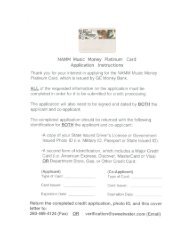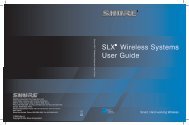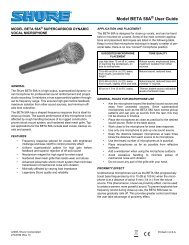You also want an ePaper? Increase the reach of your titles
YUMPU automatically turns print PDFs into web optimized ePapers that Google loves.
Performance Functions and Effects<br />
Choosing from the Performance list<br />
Parameter Value Explanation<br />
1. In the Main screen, use the cursor buttons to move the<br />
cursor to the Performance number.<br />
2. Press [ENTER].<br />
Octave<br />
Lower<br />
-4–+4<br />
STANDARD<br />
Raises or lowers the pitch in steps<br />
of one octave for the Lower Tone.<br />
This lets you use simple fingering<br />
to specify a chord without having<br />
to play all the notes in the chord.<br />
3. Use [ ] [ ] to select “Preset” or “User.”<br />
You’ll be able to select preset Performances if you choose<br />
“Preset,” or user Performances if you choose “User.”<br />
PIANO<br />
The chord will consist of only the<br />
note(s) you play on the keyboard<br />
in the Lower Part.<br />
4. Use [ ] [ ] or the VALUE dial to select a Performance.<br />
5. Press [ENTER] to set the Performance.<br />
If you press [EXIT] without pressing [ENTER], the list will<br />
close without the currently selected Performance being<br />
changed.<br />
Editing a Performance<br />
You can edit the settings of a Performance, and store them as<br />
a user Performance.<br />
1. Press [MENU].<br />
2. Use [ ] [ ] to select “Perform Edit” then press [ENTER].<br />
3. Use [ ] [ ] to select a parameter, and turn the VALUE<br />
dial to select the value.<br />
4. When you’ve finished making settings, press [EXIT].<br />
The Main screen will appear.<br />
“Saving a Performance ([WRITE])” (p. 41)<br />
Performance Parameters<br />
Parameter Value Explanation<br />
Split Point<br />
Octave<br />
Upper<br />
C#2–C7<br />
-4–+4<br />
Specifies the Split Point (the key at<br />
which the keyboard will be<br />
divided) used in Split mode. This<br />
will be the highest note of the<br />
Lower Part.<br />
Raises or lowers the pitch in steps<br />
of one octave for the Upper Tone.<br />
* In the case of a rhythm set,<br />
this does not transpose the<br />
pitch; rather, it shifts the set of<br />
drum/percussion sounds that<br />
are assigned to the keyboard.<br />
Chord<br />
Mode<br />
Backing<br />
Hold<br />
Bass<br />
Inversion<br />
INTEL<br />
EASY<br />
You can play chords as described<br />
in “Chord Intelligence” (p. 102).<br />
You can specify chords in the<br />
following four ways.<br />
Major chords: Play the root note<br />
of the chord<br />
Minor chords: Play the root note<br />
and the black key located at its<br />
left<br />
Seventh chords: Play the root note<br />
and the white key located at its<br />
left<br />
Minor seventh chords: Play the<br />
root note + black key at left +<br />
white key at left<br />
Selects how the backing part will sound.<br />
OFF<br />
ON<br />
When you take your hand off the<br />
left side of the keyboard,<br />
instrumental sounds other than the<br />
drums of the backing part will<br />
stop; only the rhythm part will<br />
continue sounding.<br />
The chord you played in the left<br />
hand will be remembered. The<br />
backing will continue playing<br />
with that chord until you play<br />
another chord.<br />
Specifies how Chord Bass will be sounded.<br />
OFF<br />
ON<br />
The root note of the chord you<br />
play will sound.<br />
The lowest note of the chord you<br />
play will sound.<br />
39
















